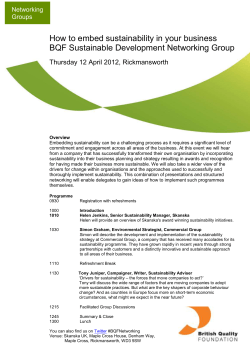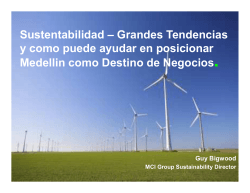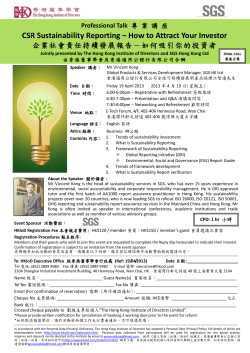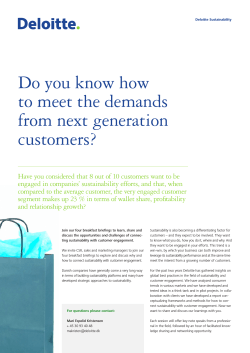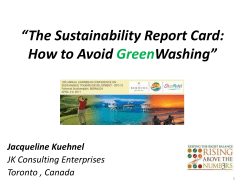
243 HOW TO DEFINE BIOECONOMY? JAK DEFINIOWAĆ BIOGOSPODARKĘ? Mariusz Maciejczak
STOWARZYSZENIE EKONOMISTÓW ROLNICTWA AGROBIZNESU HOW ITO DEFINE BIOECONOMY? Roczniki Naukowe ● tom XV ● zeszyt 4 243 Mariusz Maciejczak1, Karen Hofreiter2 1 Warsaw University of Life Sciences – SGGW, Poland, 2Technische Universitaet Muenchen, Germany HOW TO DEFINE BIOECONOMY? JAK DEFINIOWAĆ BIOGOSPODARKĘ? Key words: bio-economy, sustainability, innovations Słowa kluczowe: biogospodarka, zrównoważony rozwój, innowacje Abstract. In this paper, a critical analysis of current bioeconomy definitions was undertaken. Having in mind all ways of defining bioeconomy, it is argued that at the core of this concept lies sustainable transformation of renewable biological resources by implementing innovation in products and processes that aim to meet both private and public expectations. The basis of such innovation is knowledge concerning life sciences. Introduction Limited natural resources, a rapidly expanding world population, and serious environmental changes, such as global warming, are the emerging challenges of the 21st century. To meet these challenges, countries are increasingly turning to technological innovation and progress in search for answers to questions such as: How can we feed the growing population? How can we lessen our dependence on non-renewable resources? How can we best use and allocate our limited resources? And finally, how do we reach sustainability when worldwide economic growth is the main focus of economic activity? With growing interest in the possible solutions biotechnological innovations can provide, a new paradigm for evaluating their role has emerged: bioeconomy [Maciejczak 2007]. While the honing of its definition may appear to be a minor exercise in semantics, in truth, economic and political implications of variations in definitions are significant. Definitions convey basic concepts and signal priorities: economic, social and technological, and serve as backbones for strategy and action plans for policies of growth. While McCormick [2010] acknowledges that the concept of bioeconomy is subjective, he posits that a better understanding of bioeconomy and its key components remains a vital foundation for growth and development. Levidow et al. [2012] build upon McCormick’s assertion, adding that the direction of growth is influenced by the definition of bioeconomy, as the definition essentially serves as an outline for political priorities and implementation strategy. Also Schmid et al. [2012] stressed that across various scientific publications, papers, communications and comments of recent years, quite different definitions have been used for the bio-economy or the bio-based economy at the European Union (EU) level. The term bioeconomy is used on its own, albeit with different meanings, as well as in conjunction with other terms like innovation or knowledge-based. Such diverse definitions make it difficult to understand which is favored by the European Commission’s (EC) development perspectives. Thus, with the expansion and importance of bioeconomy, a consistent, clear, and well-considered definition informing all sectors of the economy, both public and private, is a vital prerequisite for policy-making. It cannot also be forgotten that bioeconomy is not unlike a traditional economy in that it, too, cannot escape inefficiencies, failures, and trade-offs that plague every economic system. If the goal of bioeconomy is to deliver profit as well as social and environmental gains [Maciejczak, 2007], care needs to be taken that strategic and regulatory action plans, and the definitions which inspire and guide them, include serious and realistic consideration of the limitations and inherent flaws of bioeconomy. All too often, definitions of bioeconomy and concepts put forth by various entities could be considered, at the core, to be narrow in scope and potentially biased toward the interests of particular groups of stakeholders [Levidow et al. 2012]. 244 Mariusz Maciejczak, Karen Hofreiter Objectives, materials and methods Several approaches are undertaken to define bioeconomy and growth based on it. This paper aims to provide a critical analysis of the components of several of the current bioeconomy definitions. It aims to analyze different approaches and look for the sustainable and innovation elements in the bioeconomy concept. The basis for discussion will be a critical literature review. Defining bioeconomy Coined in 1997 by Juan Enriquez and Rodrigo Martinez, at a genomics seminar, the concept of bioeconomy took off, becoming the basis for formal initiatives in the European Union and several countries, including the United States. The term is widely used by regional development agencies, international organizations and biotechnology companies. It is closely linked to the evolution of the biotechnology industry. The ability to study, understand and manipulate genetic material has been possible due to scientific breakthroughs and technological progress. In 2012, the Obama Administration put forth the “National Bioeconomy Blueprint”, which outlines the strategic objectives for capitalizing upon the potential of U.S. bioeconomy. The EC has released multiple reports and action plans, including “A Bioeconomy for Europe” in 2010 and most recently, in 2012, “Innovating for Sustainable Growth: a Bioeconomy for Europe.” While these reports emphasize the importance of embracing bioeconomy, the definitions of just exactly what bioeconomy encompasses are far ranging. In one of the earliest definitions, Enriquez and Martinez [1998] describe bioeconomy as all economic activity derived from scientific and/or research activity focused on understanding mechanisms and processes at genetic/molecular levels and its application to industrial process [Martinez, 1998]. However currently, a clear consensus on the concept of bioeconomy does not exist. The closest to a political definition is put forth by the European Commission’s report [2012]. It is defined that specifically, bioeconomy has the potential to provide and protect public goods and address social needs while promoting sustainable production of renewable resources from land and sea and their conversion into food and bio-based products. However, additional statements made by the EC suggest that the bioeconomy concept has not been cemented, with layered meanings and competing assertions. The EC is not the only institution exacerbating the confusion. There are also many more general, scientific or theoretical doubts about the mainstream of the concept. Since the term was coined in 1997, the definition has evolved, broadening and narrowing, growing and slenderizing, and shifting emphasis. In the table, 13 definitions are presented. The selection criteria were the quotation of a given definition used as a reference by an author. There are 5 definitions that underline the importance of sustainability issues in the elaboration of the concept, while 4 definitions mention the role of knowledge, research or innovation. What is characteristic, from the semantic analysis of the elaborated bioeconomy definitions, is that they differ mostly when defining the input and output of biotechnological processes. With regard to input, they mostly focus on renewable sources coming from agricultural production, some stress land and sea biological sources, and there is only one that mentions biological waste. As far as output is concerned, the definitions mention food, health, chemical and energy sectors. Only one definition incorporates the problem of public goods and one, the call for competitiveness. One possible reason for the variation in definitions could be stakeholder motives. For example, pharmaceutical companies may favour a definition that puts innovation and research and development (R&D) at the forefront. In contrast, an environmental organization might put more support behind a definition that prioritizes sustainability. Definitions that are too skewed toward the private interests of one stakeholder group or industry may result in policies that are not socially-optimal. Such a narrow perspective limits bioeconomy from reaching its full potential and essentially results in an economy not so different from, and with little more to offer than a traditional one; the main difference – replacing non-renewable resources and chemical inputs to production with renewable resources and “natural” inputs – becomes rather meaningless in terms of negative externalizations and sustainability. While there are many factors that contribute to the failure to reach a socially-optimal result in an economy, it is justifiable to focus on externalizations, specifically those arising from the unchecked interests of a stakeholder group that might dominate the bioeconomy landscape, resulting from skewed policies influenced by a particular bioeconomy definition. HOW TO DEFINE BIOECONOMY? 245 Table 1. Definitions of bioeconomy Tabela 1. Definicje bioekonomii Year of Author/Autor Definition of bioeconomy/Definicje bioekonomii publication/Rok publikacji an economy using biological resources from the land and sea as well as waste, including food wastes, as inputs to industry and energy production, it also covers European the use of bio-based processes to green industries/ekonomia wykorzystująca Commission/ 2012 zasoby biologiczne pochodzenia lądowego lub morskiego, jak i pochodzące Komisja z odpadów, włącznie z resztkami pożywienia, jako wkład do przemysłu i Europejska generowania energii, obejmuje również zastosowanie procesów bio w przemyśle przyjaznym środowisku. based on the use of research and innovation in the biological sciences to create The White economic activity and public benefit/oparta na zastosowaniu badań i innowacji 2012 House/Biały w naukach biologicznych w celu napędzania aktywności ekonomicznej oraz Dom generowania zysków publicznych. an economy where the basic building blocks for materials, chemicals and energy are derived from renewable biological resources, such as plant and 2011 McCormick animal sources/ekonomia, w której podstawowe części składowe materiałów, chemikaliów i energii pochodzą z odnawialnych zasobów biologicznych takich jak zasoby roślinne i zwierzęce. EPSO/ the sustainable production and conversion of biomass, for a range of food, health, Europejski fibre and industrial products and energy/przyjazna dla środowiska produkcja i 2011 Urząd przetwarzanie biomasy, na poczet wytworzenia gamy produktów spożywczych, Doboru Kadr zdrowotnych, włókienniczych i przemysłowych oraz energii production paradigms that rely on biological processes and, as with natural ecosystems, use natural inputs, expend minimum amounts of energy and do not European produce waste as all materials discarded by one process are inputs for another Commission/ process and are re-used in the ecosystem/modele produkcji opierające się na 2010 Komisja procesach biologicznych i, tak jak w naturalnych ekosystemach, używające Europejska naturalnych materiałów, zużywające minimalne ilości energii i nie generujące odpadków, jako że wszystkie odpadki powstałe w wyniku jednego procesu są materiałem dla następnego, co za tym idzie, są ponownie używane w ekosystemie part of the economy that generates growth and jobs from the development, Geoghegan/ processing and use of biological resources in an environmentally sustainable 2010 Quinn manner/część ekonomi, która poprzez rozwój generuje wzrost i tworzy miejsca pracy, procesując i używając zasobów biologicznych w sposób przyjazny środowisku all sectors which derive their products from biomass/wszystkie sektory, których 2010 BECOTEPS produkty są pochodnymi biomasy OECD/ Organizacja transforming life science knowledge into new, sustainable, eco-efficient and 2009 Współpracy competitive products/zmienianie wiedzy płynącej z nauk przyrodniczych na Gospodarczej nowe, przyjazne środowisku, eko-wydajne i konkurencyjne produkty i Rozwoju economic activities which capture the latent value in biological processes and renewable bioresources to produce improved health and sustainable growth 2007 DEFRA and development/działalność ekonomiczna, która chwyta ukrytą w procesach biologicznych i odnawialnych bio-zasobach wartość, co skutkuje lepszym zdrowiem, wzrostem oraz rozwójem przyjaznym środowisku. encompasses the production of renewable biological resources and their Cologne conversion into food, feed, bio-based products and bioenergy/obejmuje 2007 paper produkcję odnawialnych zasobów biologicznych oraz ich przetwarzanie na pożywienie, paszę, produkty bio i bioenergię 246 Mariusz Maciejczak, Karen Hofreiter Table 1. Continuation all production systems involving biophysical and biochemical processes, and thus includes all of the life sciences and related generic technologies necessary to make useful products; applications of biotechnology in agriculture and industry, such for bio-refineries, bio-energy and bio-chemicals, are an integral part of the bio-based economy; it also includes novel forms of land and sea usage (such as those enhancing ecosystems services and other public goods) as well as the use of materials currently considered as wastes/wszystkie systemy produkcyjne, które 2006 DG Research korzystają z procesów biochemicznych i biofizycznych, w tym wszystkie nauki przyrodnicze oraz pokrewne technologie ogólne niezbędne do wyprodukowania przydatnych produktów; zastosowanie biotechnologii w rolnictwie i przemyśle, bio-rafinerie, bio-energia I bio-chemikalia, są integralną częścią bioekonomii; termin ten obejmuje również nowatorskie formy użytkowania lądu i morza (tak jak te ulepszające pracę ekosystemu o innych dóbr publicznych) jak i pożytkowanie materiałów obecnie uznawanych za odpady the sustainable, eco-efficient transformation of renewable biological resources into food, energy and other industrial products/przyjazna środowisku eko2005 DG Research wydajna transformacja odnawialnych zasobów biologicznych na pożywienie, energię i inne produkty przemysłowe. all economic activity derived from scientific and/or research activity focused on understanding mechanisms and processes at the genetic/molecular levels and Enriquez and its application to industrial proces/wszystkie formy działalności ekonomicznej 1997 Martinez`q2 wynikające z działalności naukowej i/lub badawczej, skupiające się na zrozumieniu mechanizmu i procesów na poziomie genetycznym/ molekularnym oraz ich zastosowaniu dla procesów przemysłowych Source: own study Źródło: opracowanie własne In contrast, when the bioeconomy paradigm is based on an agroecology narrative, loosely characterized as agricultural systems designed to require a minimal amount of external inputs [Birch et al., 2012] and take advantage of ecological interactions in order to increase soil fertility, productivity, and protection of crops, it can deliver public goods [En Route to… 2007]. For example, agricultural methods that responsibly manage land, incorporating more efficient use of renewable resources, farmer knowledge, minimization of external inputs to agriculture production and integrated farming methods, to name a few, provide public goods. This is one of the reasons highlighting the importance of creating a bioeconomy definition that emphasizes a concept and strategy that takes advantage of and encourages the unique ability of bioeconomy. Several authors [Levidow et al. 2012, Schmid et al. 2012] argue that a mostly industrial perspective does not accomplish this. Bioeconomy and sustainability Other than emphasis on public goods, a bioeconomy definition must place importance on sustainability, taking into consideration inter-temporal externalizations. However, it is not enough to simply have the word “sustainable” or “sustainability” in the definition. To be truly sustainable, the interpretation of the word must be closer to that of the definition put forth by the Brundtland report by the United Nations World Commission on Environment and Development [1987], namely development that meets the needs of the present without compromising the ability of future generations to meet their own needs. Indeed, there are divergent interpretations of “sustainability.” For example, in the “life sciences” or “industrial” approach, sustainability is the idea of eco-efficiency, which is now equated with sustainable development. As stressed by Birch et al. [2012] such an approach to bioeconomy links environmental and economic sustainability through life sciences: living matter will be used more efficiently, thus substituting fossil fuels and synthetic chemicals. In this vision, sustainability is equated with redesigning and using renewable raw materials more efficiently, as a basis of enhancing global economic competitiveness and thus, European prosperity. HOW TO DEFINE BIOECONOMY? 247 In contrast, the agroecology narrative equates sustainability with the idea of working with the environment and natural processes rather than trying to alter them through engineering and transformation. Gliessman [1998] argues that sustainability is achieved through alternative agricultural practices informed by in-depth knowledge of ecological processes occurring in farm fields and the larger landscape of which they are a part. This narrative acknowledges that environmental sustainability cannot be decoupled from social systems (i.e., economic, cultural, political); hence, the increase in social welfare, both for current and future generations, from the production of public goods is an important contribution to sustainable resource use and societies [Freibauer et al. 2011, Takács-György et al. 2013, Takács et al. 2012, Nagy, Káposzta 2003]. Bioeconomy and innovation Innovation is central to the proliferation and progress of bioeconomy. Again, there is an issue of what encompasses innovation, what the priorities for innovation should be, and where innovation should come from. From an industrial perspective, the purposes of innovation, primarily according to the EU, include increased global competitiveness, economic growth (or at least no slow down), profit increases, positive public relations, and monetary advantages from intellectual property patents. In its “Strategy and Bioeconomy Action Plan 2012”, the EC assumes to improve the knowledge base and foster innovation for producing quality biomass (e.g. industrial crops) at a competitive price. In this perspective, innovation is mostly the product of knowledge stock created through private and public R&D. The focuses of R&D leading to innovation include genetic engineering; more efficient use of renewable resources; increases in land productivity; development of new markets for new bio-based products; and creation of functional foods. The value of contributions from farmers and small and medium-sized enterprises, local knowledge and capabilities, and the need for innovations targeted at social problems are often placed at the bottom of the list of priorities or ignored. From the public goods/agroecology perspective, the primary purposes of innovation include provision of public goods; eco-functional intensification of agriculture; shorter food-supply chains; more efficient production of energy; carbon sequestration; soil protection; and maximization of the benefits from multi-method farming. Economic growth from innovation is also a goal, but it is a goal to be achieved through a broader, systems-based approach, which can help turn research into economic growth whilst at the same time providing public goods. Along the same line, innovative solutions should be adapted to the whole supply chain as well as the growing bio-based economy. Innovation should not only come from R&D but also from the knowledge and ideas of farmers, and there should be a participatory approach to knowledge and innovation. Focusing on “innovation-driven research” (bottom-up, interactive) as opposed to “science-driven research” (top-down, from R&D), it is important to prioritizes that the innovation process and success is enhanced by networks of different stakeholders exchanging ideas and learning from one another. In as much, there is a need to move from ideas about one-way ‘knowledge transfer’ to processes that will facilitate ‘knowledge exchange’, that should enable greater participation in the innovation process [Agricultural Knowledge… 2012]. Conclusions The bioeconomy concept is a merit-worthy and an innovative approach to an economy of the future, a future likely to be challenged by global population growth, climate change, declining non-renewable resource stock, water shortages, and environmental degradation. However, the success of bioeconomy will depend on how it is implemented and fostered. There is still much research and analysis to be conducted, although it is not to say that the implementation of bioeconomy should be stalled. Rather, there should be a general consensus on its definition and concept, both of which should envision sustainable economic, environmental, and social welfare as well as innovation and competitiveness approaches. Having in mind all approaches defining bioeconomy, it should be acknowledged that at the core of this concept lies sustainable transformation of renewable biological resources based on life science’s innovations into products and processes that aim to meet both private and public expectations. 248 Mariusz Maciejczak, Karen Hofreiter Bibliography A Bioeconomy for Europe. 2010: European Commission, Brussels. Agricultural Knowledge and Innovation Systems in Transition: a Reflection Paper. 2012: EU SCAR ec.europa.ed/ research/agriculture/scar/pdf/akis_web.pdf, accessed 28.04.2013. Bio-Economy Technology Platforms, BECOTEPS 2010: Project presentation, European Technology Platforms Conference, www.becoteps.org, read 2013-02-20. Birch K., Levidow L., Papaioannou T. 2012: EU agri-innovation policy: two contending visions of the bio-economy, Critical Policy Studies, no. 6(1), p. 40-65. En Route to the Knowledge-Based Bio-Economy. 2007: Cologne paper. http://www.bio-economy.net/reports/files/ koln_paper.pdf, accessed 28.04.2013. FP7 Theme 2: Food, Agriculture, Fisheries and Biotechnology. 2006: DG Research, 2007 work programme Freibauer A., Mathijs E., Brunori G., Damianova Z., Faroult E., Girona i Gomis J., O’Brien L., Treyer S. 2011: The 3rd SCAR Foresight Exercise. Sustainable Food Consumption and Production in a Resource-Contrained World, EU Standing Committee on Agricultural Research (SCAR), Brussels. Gliessman S. 1998: Agroecology and Sustainability, INTECOL Symposium 8.2. agroecology.org/documents/ Intecolrep.pdf. Innovating for Sustainable Growth: A Bioeconomy for Europe 2012: European Commission, Brussels. Levidow L., Padel S., Schmid O. 2012: The Bio-Economy Concept and Knowledge Base in Public Goods and Farmer Perspective, Bio-based and Applied Economics, 1(1), p. 47-63. Maciejczak M. 2007: Agricultural based bioeconomy—seeking sustainable solutions, www.maciejczak.pl McCormick K. 2010: The knowledge-based bio-economy in Europe, International Institute for Industrial Environmental Economics, Lund, Sweden. Martinez J. 1998: Genomics and the World’s Economy, Science Magazine, vol. 281, no. 5379, pp. 925-926. Nagy H., Káposzta J. 2003: The role of multifunctional environmental policy in the agricultural development, Annals Of The Polish Association Of Agricultural And Agribusiness Economists, vol. 5, pp. 28-34 New perspectives on knowledge based bio-economy. 2005: DG Research. Conference report. Brussels, 14-15.09.2005. Schmid O., Padel S., Levidow L. 2012: The Bio-Economy Concept and Knowledge Base in a Public Goods and Farmer Perspective, Bio-based and Applied Economics, 1(1), p. 47-63. Takács I., Nagy-Kovács E., Holló E., Marselek S. 2012: Model for optimization of biomass utilization of energy production by energetic and economic requirements, Review of Applied Socio-Economic Research, volume 4, Issue 2/ 2012, pp. 225. Takács-György K., Lencsés E., Takács I. 2013: Economic benefits of precision weed control and why its uptake is so slow, Studies in Agricultural Economics, 2013/115/1, pp. 40-46. The Bioeconomy to 2030: Designing a Policy Agenda, Maine Findings and Policy Conclusions. 2009: OECD, International Futures Project. The European Bioeconomy in 2030: Delivering Sustainable Growth by addressing the Grand Societal Challenges. 2011: EPSO European Plant Science Organisation, www.europabio.org/EU%20Projects/bioeconomy-2030-becoteps-final-white-paper.pdf, accessed 28.04.2013. The White House. 2012: National Bioeconomy Blueprint, Washington DC. UK Biomass Strategy. 2007: DEFRA White Policy paper, London. United Nations World Commission on Environment and Development (WCED). 1987: Our Common Future. Oxford: Oxford University Press. p. 27. Streszczenie Dokonano krytycznej analizy wybranych definicji biogospodarki. Uwzględniając różne podejścia do definiowania biogospodarki należy wskazać, że w rdzeniu tego pojęcia jest zrównoważone wykorzystanie odnawialnych zasobów biologicznych przez innowacje, których źródłem jest wiedza z obszaru nauk przyrodniczych w produkty i procesy, które mają do spełnienia zarówno prywatne jak, i publiczne oczekiwania. Mariusz Maciejczak, Ph.D. Warsaw University of Life Sciences – SGGW 166 Nowoursynowska St., 02-787 Warsaw, Poland tel. +48 22 593 42 35 e-mail: mariusz_maciejczak@sggw.pl Correspondence address Karen Hofreiter, M.Sc. Technische Universitet Munchen Arcisstrasse 21 St. 80333 München, Germany e-mail: khofreiter@gmail.com
© Copyright 2025






